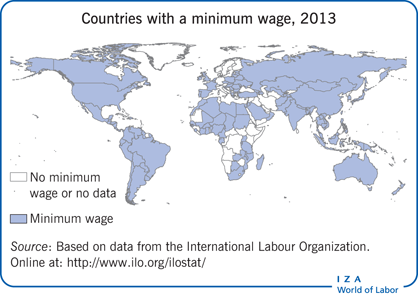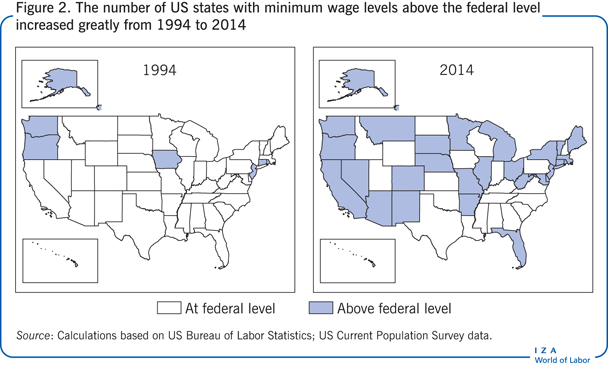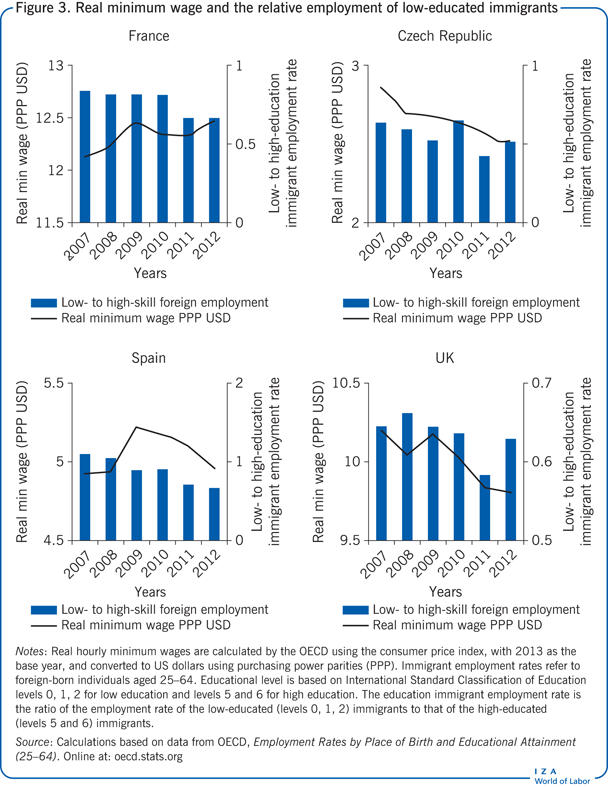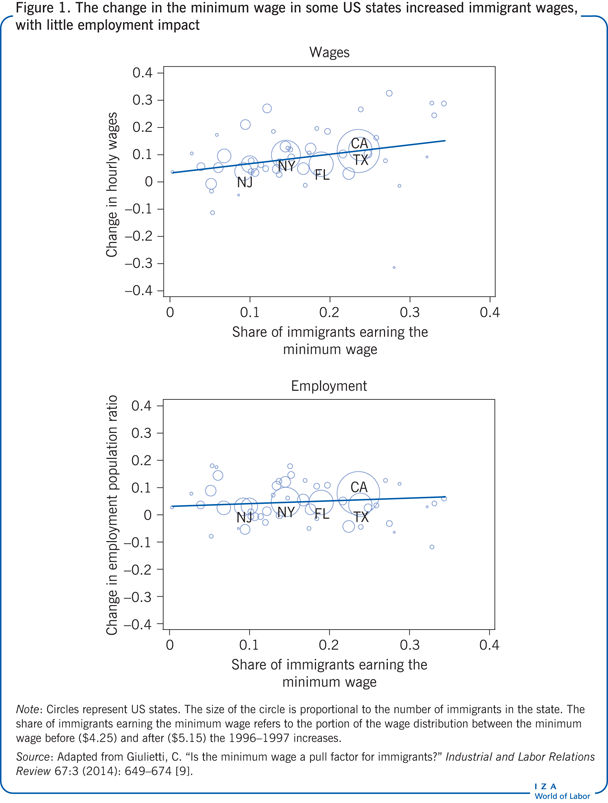Elevator pitch
An increase in the minimum wage in immigrant destination countries raises the earnings that low-skilled migrants could expect to attain if they were to migrate. While some studies for the US indicate that a higher minimum wage induces immigration, contrasting evidence shows that immigrants are less likely to move into areas with higher or more frequent increases in the minimum wage. These different findings seem to reflect different relocation decisions by immigrants who have lived in the US for several years, who are more likely to move in response to higher minimum wages, and by new immigrants, who are less likely to move.

Key findings
Pros
Theory predicts that an increase in the minimum wage raises the wage that immigrants expect to attain in the destination country.
There is evidence that minimum wage policies do not negatively affect the employment of recently arrived immigrants.
Empirical findings suggest that immigrants react to the minimum wage by relocating within the country, thereby relaxing downward pressure on the employment of native-born workers.
Some empirical evidence implies that the minimum wage does not affect the inflow of undocumented immigrants.
Cons
Other empirical evidence suggests that a minimum wage increases the supply of low-skilled immigrants, possibly tightening job competition for low-skilled natives and earlier immigrants.
An increase in the minimum wage induces migrants who have been in the country longer to relocate, potentially disrupting their assimilation.
A dearth of empirical evidence makes it difficult to predict the response of immigration to changes in the minimum wage, especially outside the US.
Findings of an immigration response to changes in the minimum wage are sensitive to the methodology applied.
Author's main message
Evidence suggests that minimum wages increase the expected earnings of low-educated immigrants, raising their prospective wage with little adverse employment effects. While mixed, the evidence indicates that a minimum wage affects immigration and the internal location choices of immigrants. Minimum wage policies do not appear to hurt the employment of recently arrived immigrants, while immigrants already in the country react by relocating within the country, relaxing downward pressure on the employment of native-born workers. Policymakers should consider the potential effects of a minimum wage on the location choices of potential immigrants abroad.
Motivation
A growing number of developed and developing countries are introducing a minimum wage or increasing an existing minimum wage—policies that aim to guarantee minimum earnings for individuals. While most researchers and policymakers focus on the consequences of the minimum wage for people living in a country, the policy could also influence the expected gains of migration, leading to an increase (or even a decrease) in the number of low-skilled workers migrating from abroad. Whether the minimum wage favors or deters migration depends on the overall wage and employments effects. Besides affecting international migration, a minimum wage policy could also lead to the redistribution of immigrants within the country if the minimum wage effects vary across regions. Whether migrants relocate within a country might also depend on how long they have lived in the country.
This paper reviews the evidence on the effects of the minimum wage on worker mobility and discusses the policy implications of these findings.
Discussion of pros and cons
The links between the minimum wage and migration
Traditional studies on minimum wage policy focus on the policy’s effects on employment. Two major strands have emerged in the literature: the first is based on the neoclassical view, while the second, more recent, strand has been referred to as the “new economics of the minimum wage.” Neoclassical models postulate that minimum wages reduce employment since firms have to pay wages that are higher than the market level [1]. The size of the employment effect depends on the elasticity of labor demand—which measures the responsiveness of firm employment to changes in the wage. Studies within the second literature strand argue that the minimum wage may not imply negative employment effects [2] if there is friction in the labor market due to scarce labor turnover or the presence of a single major employer (monopsony) [3].
Empirical studies on the effects of a minimum wage usually focus on teenagers, since they are typically heavily employed in industries where the minimum wage bites (wages are below the minimum wage before the new policy is introduced). However, the policy could substantially affect the wages and employment of other groups working in low-wage industries as well, such as immigrants. A study using US Current Population Survey monthly data for 1995–1998 found that before the 1996–1997 increases in the minimum wage in the US, more than 11.1% of male immigrants and 14.6% of female immigrants aged 16–64 earned the minimum wage or below it [4]. The increase in the US federal minimum wage led to a 7–8% wage increase for immigrants. The increase was about the same as that for native-born workers and was the same in industries with high concentrations of immigrants as in those with low concentrations. Another study using Current Population Survey data for 1994–2005 found that 9.6% of male immigrants and 18.6% of female immigrants aged 20–54 without a high school degree earned the minimum wage or below. A 10% increase in the state minimum wage was associated with an increase of about 2% in the average wage of less-educated immigrants. The policy had essentially no impact on employment for either immigrant men or women [5].
If the minimum wage affects the outcomes of immigrants living in the US, it is possible that the policy could also influence outcomes for potential migrants, based on expected earnings. Since the decision to migrate depends, in part, on differences in labor markets between potential destination countries and the country of origin, changes in the minimum wage in the potential destination region might favor or deter migration. A similar argument is advocated in the literature exploring the role of welfare generosity (such as unemployment benefits) in influencing immigration.
The link between minimum wage policy and labor movement was first hypothesized in the context of developing countries, where the minimum wage was thought to explain high levels of urban unemployment. The key aspect of such a framework is that individuals who plan to migrate from rural to urban areas make decisions based on expected (rather than actual) earnings [6]. Workers continue to migrate from rural to urban areas up to the point at which the expected minimum wage in urban areas is equivalent to the actual earnings attainable in the rural/agricultural sector. Thus, since there is an excess of labor that migrated to the city, a part of it remains unemployed. This conceptual framework has also been extended to international migration decisions and incorporates both immigration to the country with the minimum wage and outmigration from the country [7]. In developed countries, the minimum wage might also influence incentives for internal labor mobility to the extent that the bite of the policy varies across regions. This is the case in the US, where states can set their own minimum wage and where the federal minimum wage can have different impacts across states.
Empirical evidence on the minimum wage and migration
Studies finding an immigration response
An early empirical study exploring the relationship between the minimum wage and international mobility investigated whether migration to the US increased as a result of the extension of the US federal minimum wage to Puerto Rico [8]. The analysis found that the extension of the minimum wage to Puerto Rico caused the minimum wage there to rise to 60% of the average wage. However, this large increase did not create a high level of unemployment in Puerto Rico because some of the low-skilled workers who lost their jobs because of the minimum wage migrated to the US.
A recent study focuses on changes in the US federal minimum wage that occurred in 1996–1997 and 2007–2009 [9]. The theoretical framework of the study incorporates the idea that changes in the federal minimum wage, because they can have different impacts across states, create independent variations across states in the expected wage that prospective low-skilled migrants from abroad could attain. The higher the expected wage, the greater the probability that immigrants will move to the US. The expected wage is the product of two components, both of which are affected by the minimum wage: the average wage of immigrants in the state and the average probability of employment. While an increase in the average wage consequent to a rise in the minimum wage is always expected, employment effects are ambiguous and depend on the structure of the labor market. If the employment effects are neutral or positive, or if they are negative yet sufficiently small not to outweigh the positive wage gains, immigration will rise. However, if negative employment effects are so large that they annihilate the wage gains, immigration will decline.
The study used information on net migration rates (the difference between migration to and from each state divided by the state’s resident population) from the US Census and the American Community Survey, as well as additional state data from the Current Population Survey. Net migration rates were higher in states where the effect of the change in the minimum wage was greater [9]. The size of this “magnet effect” was substantial. For example, in New York, where expected wages grew 14.6%, the net migration rate was about 0.61%, while in California, where expected wages grew 18%, the net migration rate was 0.80%. These estimates take into account the potential reverse causality effect of immigration—immigration can influence wages and employment at the destination as well as being influenced by them. The analysis found that the change in the minimum wage increased the wage of immigrants, with essentially no employment consequences, so the overall effect of the policy for immigrants was positive (Figure 1).
Corroborating this finding, the analysis shows that high-skilled immigrants (those with at least a high school degree) do not react to the minimum wage, since they already earn a higher wage [9]. The most affected immigrants are young men (aged 16–30) from Central and South America. Drawing on data from the Border Survey of Mexican Migration (Encuesta sobre Migracion en la Frontera Norte de Mexico), the study shows that the US federal minimum wage attracted only legal immigrants to the US. One reason that it might not have affected the flow of undocumented migrants is that they generally earn below the minimum wage because they often work in the unregulated economy.
Studies finding negative immigration effects
Another recent study, which also postulates that workers make decisions to migrate based on expected wages, provides contrasting evidence on the effects of the minimum wage on immigration [10]. The model predicts that if demand for low-skilled labor is particularly elastic to changes in the minimum wage, migrants would tend to move out of states that set a higher minimum wage. But if demand for low-skilled labor is rigid, migrants will tend to move into states with a higher minimum wage. The model considers immigrants and native teenagers to be substitutes in the labor market—they work in the same occupations or sectors. Therefore, depending on whether migrants flow into or out of states with higher minimum wages, there will be stronger or weaker negative employment effects for native teenagers. In practice, the location choice of migrants is a mechanism for re-equilibrating the labor market effects of the minimum wage.
The study uses US Current Population Survey data for 1994–2007, drawing on monthly information on state minimum wages and other state-level characteristics. This framework exploits the fact that a growing number of states have introduced a minimum wage higher than the federal level over time (Figure 2). The analysis shows that when the state minimum wage rises 10%, there is an 8% reduction in the number of low-skilled immigrants, a combined effect of lower immigrant inflows, higher return migration, and internal redistribution of migrants across states [10]. The study finds no effect on the location choice of high-skilled immigrants (those with at least some college education). The outflow of migrants from states with higher minimum wages helps to mitigate the negative effects of the policy on the employment of native teenagers.

These results are consistent with those of another study that also found no negative effects of the minimum wage on the employment of immigrants [5]. The study hypothesizes that immigrants who are unemployed due to the minimum wage decide to move to states with lower or no minimum wage. The empirical results suggest that low-skilled immigrants tend not to choose states with higher minimum wages.
Why are there different results on the immigration effects of the minimum wage?
The contrasting results for the immigration effects of the minimum wage can be partly attributed to the different periods of analysis and different methodologies used in the studies. For instance, one study used changes in the federal policy and the consequent state variation to identify the migration results [9], whereas the other two studies used panel data analysis at the state level [5], [10]. These different methodologies are known to produce divergent results for employment effects, since they involve different comparison sets (different “control groups”). The first methodology compares a state before and after it introduces a minimum wage or compares a state with a minimum wage with a neighboring state that has similar macroeconomic characteristics but no minimum wage. Panel data analyses, in contrast, compare all states with a minimum wage with all states without a minimum wage. Furthermore, panel data methods yield different results depending on how the analysis accounts for state-specific trends in macroeconomic variables. For example, linear state-specific trends within a regression framework might create a spurious correlation between minimum wages and employment, especially if changes in the policy follow the business cycle. By contrast, more sophisticated techniques (such as higher order polynomials) might better control for changes in the business cycle (recessions and booms).
Another possible explanation is that the effect on immigration could depend on whether the analysis focuses on recent flows of immigrants or on immigrants who have lived in the country for some time. For example, the design of the study that focuses on the differential effects across states of changes in the US federal minimum wage in 1996–1997 [9] implies that it accounts for only recent flows of immigrants, as the results refer to differences in net immigration rates that occur two to three years after the policy’s introduction. On the other hand, the study using panel data focuses on immigrants who have been in the US for up to 10 years [10]. The minimum wage could have different impacts for recently arrived immigrants and for established immigrants—for instance, the probabilities of returning home and of relocating to other states could be different for the two groups.
This potential explanation is compatible with the findings of another study that also uses Current Population Survey panel data at the state level for 1994–2007 [11]. The analysis shows a positive effect of the minimum wage on the number of immigrants who have been in the US for less than four years but a negative effect on the number of immigrants who have been in the country for seven or more years (although the estimates are not statistically significant). This implies that more recent immigrants living in the US are attracted to states with higher minimum wages, while immigrants who have been in the country longer tend to leave states with higher minimum wages, either to move to areas with lower minimum wages or to return to their home country. The speed of such adjustment likely depends on the extent to which newly arrived immigrant workers are substitutes for existing immigrants, as well as how the two types of immigrants cluster across industries and geographic areas.
Evidence for other developed countries
While the number of studies on the effects of the minimum wage on immigration to the US is growing, evidence is still scant for other countries. This is somewhat surprising considering that a majority of countries (including low- and medium-income countries) now have minimum wage legislation (see Illustration).
A recent study investigating the effects of labor market institutions on immigration from 221 countries of origin to 15 OECD countries during 1980–2006 finds a positive correlation between immigration flows and the minimum wage [12]. However, the econometric strategy used in the analysis implies that this positive effect has to be interpreted with reference to the introduction of—and not to an increase in—a minimum wage. Since the UK was the only country making the switch from no minimum wage to a minimum wage regime during the period of analysis, this positive effect can refer only to the UK.
While the study reflects an effort to fill a gap in the literature, it also reveals the many difficulties of undertaking a comprehensive cross-country evaluation of the effects of the minimum wage on immigration. Some OECD countries (like Italy) do not have a minimum wage, while others (like Germany) have only recently introduced one. In countries that have a minimum wage policy, the wage can be set at different levels—national, regional, or industry. Furthermore, there are marked differences in labor market institutions, migration policies, and even data collection and measurement of migration flows, thus making cross-country comparison arduous.
Some of these cross-country differences can be inferred from an analysis of recent statistics. Figure 3 shows the variation in the real minimum wage in four European countries over time. While this measure does not capture the real bite of the minimum wage, since there can be substantial differences in average and median wages across countries, it provides a picture of changes over time in the selected countries. Figure 3 also plots the ratio of the employment rate of low-educated immigrants to that of high-educated immigrants; larger values indicate that the employment of low-educated immigrants (those more likely to be affected by the minimum wage) is high compared with that of the high-educated group.

While this measure is just a proxy and is likely to capture both immigration and employment effects of the minimum wage, it is helpful in illuminating differences across countries and patterns over time. A mixed picture emerges: while the low- to high-educated immigrant employment ratio is positively related to the real minimum wage across most years for the Czech Republic and the UK, a positive association is visible only in some years in France and Spain, with a negative association in the remaining years, suggesting that in these two countries the minimum wage might have first incentivized and then deterred migration from abroad.
In summary, it is possible that the effect of the minimum wage on immigration varies substantially across OECD countries. Accordingly, further empirical evidence is needed to understand the magnitude and direction of the effect.
Limitations and gaps
The empirical evidence on how the minimum wage affects immigration remains scarce and reaches dissimilar conclusions. Some studies find the minimum wage to be a magnet for immigration, while others obtain opposite results. Further evidence is needed to reconcile these contrasting results.
Despite the ubiquity of minimum wages and immigration, most studies focus on the US. In particular, there is no evidence on whether and how minimum wage policy affects immigration from nearby developing countries, as well as rural to urban migration within countries. Especially in developing countries, a large informal sector undercuts compliance with a minimum wage and likely absorbs part of the immigration effects that the minimum wage might have on the formal sector.
While data collection methodologies are improving, it is usually difficult to identify minimum wage workers through survey data, which creates measurement problems. Similarly, the scarcity of annual data on migration flows by skill level makes it difficult to undertake a comprehensive analysis over time. To compensate, researchers are forced to use either low-frequency data, or high-frequency data, which requires that they reconstruct migration flows using migrant stock data.
Summary and policy advice
While there is some evidence that low-skilled immigrants are attracted by higher minimum wages, other studies show that the policy deters immigration. Despite these mixed findings, the evidence does suggest that the minimum wage has an effect on immigration: the policy influences international migration flows, as well as the internal location choices of immigrants. Immigrants’ internal mobility seems to depend on their length of stay in the country. Accordingly, the finding that immigrants who have been in the country longer are more likely to relocate across regions as a consequence of increases in the minimum wage suggests that the policy might disrupt the assimilation of migrants who have established roots in certain areas.
When introducing or raising the minimum wage, policymakers should consider the potential effects of the policy on the migration choices of individuals living abroad. Furthermore, minimum wage and immigration policies should be coordinated if central and local governments wish to control the effects of the minimum wage beyond local borders.
Acknowledgments
The author would like to thank two anonymous referees and the IZA World of Labor editors for many helpful suggestions on earlier drafts. Previous work of the author contains a larger number of background references for the material presented here and has been used intensively in all major parts of this article [9].
Competing interests
The IZA World of Labor project is committed to the IZA Guiding Principles of Research Integrity. The author declares to have observed these principles.
© Corrado Giulietti
